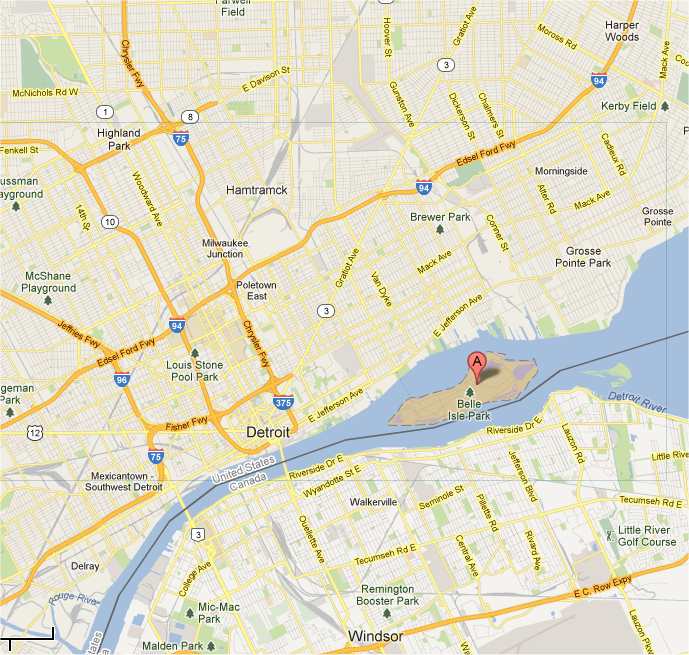Detroit Belle Isle - Biking and Kayaking
Gallery 1 - Photos of Biking Belle Isle #1
Gallery 2 - Photos of Biking Belle Isle #2 Gallery 3 - Video on Belle IsleGallery 4 - Kayaking Belle Isle
Gallery 5 - Freighters passing by Belle Isle
Gallery 6 - Swimming on Belle Isle
These galleries are of my biking and kayaking of Belle Isle on July 12 and 13, 2011. Also included is a bike ride through the historical neighborhood of Indian Village across the street from Belle Isle.
Belle Isle is 982 acre island park in Detroit on the Detroit River between Detroit and Canada that can be reached via the ½ mile MacArthur bridge off Jefferson Avenue at East Grand Blvd. just east of downtown Detroit. It's a very nice park with quite a bit to offer and is actively used for racquetball, softball, golf, swimming, water slide, basketball, picnics, fishing, bike path, soccer, baseball, tennis, and of course, and cruising in the car. It also has a lot of beautiful buildings and a very nice Yacht Club. It is the largest city-owned park in the United States and the third largest island in the Detroit River after Grosse Isle and Fighting Island.
History of the Island: Pre Detroit Ownership
In examining the history of Detroit, it may be useful to summarize the history of Detroit. Detroit can be considered: a) pre-settled by Europeans before 1701, b) occupied by the French from 1701 to 1760, c) occupied by the British from 1760 to 1796 and, d) American owned from 1796 onwards.
Ottawas and Ojibwa indian tribes were once the "owners" of the island which was settled by French colonists in the 18th century who named it Île aux Cochons, or Hog Island. It was used by settlers to house pigs and chickens to protect them from coyotes on the mainland. On May 4, 1768, Lieutenant George McDougall, a soldier in the British garrison at Detroit, was given permission by King George III to "occupy" Belle Isle. Despite the fact that the citizens of Detroit would lose their rights to the island and have to find other means of housing cattle and other animals, McDougall purchased the island on June 5, 1769 from the Ojibwa and Ottawa owners for a total of 8 barrels of rum, 3 rolls of tobacco, 6 pounds of vermillion, and a wampum belt.
Detroiters who were living on the island at the time, including Jacques Campau, J. Bte. Chapoton, Eustache Gamelin, and Pierre Reaume, wrote a letter to Captain Turnbull (commandant of Detroit) on May 18, 1769. The letter asked that Turnbull speak to General Thomas Gage and Governor Carleton and request the citizens' rights to use Belle Isle be recognized. Turnbull refused. The citizens then wrote to Gage and Carleton themselves. Again they were refused. A meeting was held on October 13, 1769 and the citizens were able to voice their opinions, but to no avail. In the spring of 1777, McDougall took full possession of the island.
In 1780, the McDougall holdings on Belle Isle were appraised by order of commandant Arent Schuyler de Peyster. Peyster aimed to use the island to increase agricultural production at the post. Mrs. Dougall was paid £334, the calculated value of her holdings. After that, the King's cattle and a Mr. Riddle moved to the island.
The Island was also once the estate of General Alexander Macomb, Jr. (1782-1841) who was born in Detroit while it was British-held. In 1845 it was given its present name. It was named in honor of the Count of Belle Isle, physician in the party of Antoine de la Mothe Cadillac who founded Fort Ponchatrain in 1701.
History of the Island: Detroit Ownership
The island was purchased by the city in 1879 for $200,000 (against the opposition of those who thought the price was too high), and the master plan was created in 1883 by Frederick Law Olmstead (designer of NYC's Central Park). They elected to retain the name Belle Isle (beautiful island) by which the property was popularly known. Visitors could enjoy the park starting in 1889 via the islands first wooden bridge. The bridge was meticulously renovated in 1986. In 1942, the bridge was renamed after General Douglas MacArthur. It is listed on the National Register of Historic Places.
Between 1903 and 1930, the Casino, the Whitcomb Conservatory and Livingstone Lighthouse were designed by Albert Kahn. Olmstead also helped select Cass Gilbert's design for the mammoth Scott Fountain, chosen over 93 other entries in a nationwide competition. Among Gilbert's other achievements was the design of the U.S. Supreme Court Building in Washington, D.C.
Park Contact Information
Belle Isle
Jefferson Avenue
Detroit, MI
Map
